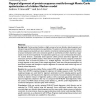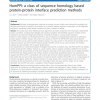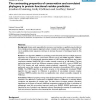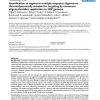93 search results - page 5 / 19 » RNA-RNA interaction prediction based on multiple sequence al... |
BMCBI
2004
13 years 7 months ago
2004
Background: Certain protein families are highly conserved across distantly related organisms and belong to large and functionally diverse superfamilies. The patterns of conservati...
BMCBI
2011
12 years 11 months ago
2011
Background: Although homology-based methods are among the most widely used methods for predicting the structure and function of proteins, the question as to whether interface sequ...
BMCBI
2008
13 years 7 months ago
2008
Background: Amino acids responsible for structure, core function or specificity may be inferred from multiple protein sequence alignments where a limited set of residue types are ...
BMCBI
2004
13 years 7 months ago
2004
Background: Computer programs for the generation of multiple sequence alignments such as "Clustal W" allow detection of regions that are most conserved among many sequen...
RECOMB
2003
Springer
14 years 7 months ago
2003
Springer
We describe a novel method for detecting the domain structure of a protein from sequence information alone. The method is based on analyzing multiple sequence alignments that are ...




